The Good Improved
speed everywhere (new processor, faster wireless, quicker Touch ID
sensor); a sturdier body; better front and rear cameras; a bold new 3D
Touch pressure-sensitive display that could end up being a really useful
tool in apps down the road, and which already offers new iOS shortcuts.
The Bad Same
battery life as the iPhone 6. The 6S Plus model remains the only way to
get optical image stabilization for photos and video, plus better
battery life. You'll need to pay extra to vault past the too-small
storage of the entry-level 16GB version.
The Bottom Line The
newest iPhones are top-to-bottom better phones with lots of
enhancements; iPhone 6 owners don't need the upgrade, but everyone else
should seriously consider it.
The first iPhone heralded the arrival of capacitive displays and
multi-touch technology. The iPhone 6S is the first to have 3D touch - a
screen technology that recognizes different levels of pressure for an
extra dimension of interaction with a device.
A late tribute perhaps to resistive screens, which Apple itself sent
to their doom. Not a particularly scientific statement although
resistive technology did rely on actual pressure to work. Good enough
for anyone with a penchant for the dramatic.
But if we are to stick to the facts, the iPhone 6s isn't the
company's first device with a pressure-aware display, the Apple Watch
is. Plus, phones like the Huawei Mate S and the ZTE Axon mini do deserve
at least a mention as well. Anyway, this only highlights the difference
between Apple and the rest. Cupertino has the habit - and in all
fairness, the capability - to pick a niche technology and make it
mainstream.
Unboxing the iPhone 6s
The retail package of the iPhone 6s will hardly surprise anyone. The
compact cardboard box contains the device itself, a well-packed pair of
EarPods, an A/C adapter and a Lightning cable.
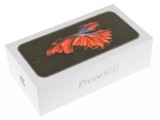
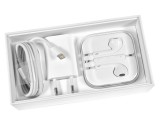 Apple iPhone 6s retail package
Apple iPhone 6s retail package
The 1A charger is very compact, but it's not going to win any speed
competitions - in the day and age of Quick Charge, VOOC and other quick
battery topping solutions, what Apple offers is rather disappointing.
And if you live in the UK, Ireland, Malta, Hong Kong, or any other
country that uses the British standard then you also lose the small size
perk as the adapter there is huge.
Apple iPhone 6s 360-degree spin
The new iPhone 6S, as the 's' suggests, pretty much reuses the
original design and only upgrades the internals. The additions of the 3D
Touch technology and the bigger camera required some minor changes
though.
For one, the iPhone 6s is a tad thicker and yet had to sacrifice some
battery capacity to accommodate the layer of pressure sensors in the
screen. Its dimensions are 138.3 x 67.1 x 7.1 mm, compared to the
original 138.1 x 67 x 6.9mm. The difference is negligible but it's bad
news if you had some tight-fitting cases for your iPhone 6 - they won't
fit on the 6s.
What's more readily noticeable is that the iPhone 6s has gained some
extra 14g of weight, again down to the pressure-sensitive layer. That's
the kind of difference you can feel in your pocket and makes the phone
heavier than the Galaxy S6 with its 5.1" screen.
Design and build quality
It may be an entirely different device within, but the exterior of
the iPhone 6s is absolutely identical to last year's iPhone 6. Packing
just 4.7 inches of screen estate it is still one of the most compact
flagships on the market, but its screen-to-body ratio is rather
unimpressive (read too much bezel). Apple has been reluctant to do
something about that for years now and things are now getting
embarrassing - there are phones with 5+" screens that have the same
footprint, while phones with equally sized displays usually come in
notably smaller packages.
There are some good news though. The iPhone 6s unibody is cast out of
7000 series aluminum instead of last year's 6000 series and it's
stronger. Latest tests revealed the iPhone 6S bends at much higher
levels of pressure than the previous generation - almost triple
actually. So, Apple has put bendgate firmly behind it and skinny jeans
are no longer an iPhone's mortal enemy.
The front is covered by an ion-strengthened glass with oleophobic
coating - those are pretty much the same specs as in the previous iPhone
models and mean the glass is scratch and smudge resistant. The Ion-X
glass creates the so-called 2.5D effect thanks to its rounded edge. By
the way, Apple claims the new special ion-exchange process makes it the
most durable screen glass among smartphones today, but early drop test
didn't provide conclusive evidence for that.
So, higher-grade durable glass and aluminum alloy should improve the
overall resilience of the phone. It still lacks water and dust
resistance, but seeing how Sony is changing its policy on those and
Samsung gave up on it for the Galaxy S6 this is less of a disadvantage
now than it was last year.
The back of the iPhone 6s is familiar - mostly aluminum, with two
plastic bands covering the antennas and a slightly protruding camera
ring. The new 12MP sensor is still protected by a small piece of
sapphire glass, so you should worry more about scratching your wooden
desk rather than damaging the camera piece.
Extra heft might have made carrying it a bit harder, but handling the
iPhone 6s is pretty much the same pleasing experience. The phone feels
great in hand thanks to the premium materials and finish but you still
need to be extra careful as the thin and rounded edges don't have the
best grip.
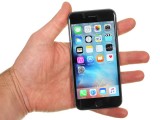
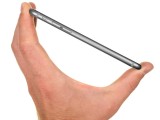 Handling the iPhone 6s
Handling the iPhone 6s
Controls
The iPhone 6S has the same control set as its predecessor. Above the
display is where the earpiece, a couple of sensors and the new 5MP
selfie camera are.
While the front facer doesn't come with a LED flash, Apple make up
for it by letting you use the screen as one. If you turn on the
so-called Retina flash the entire screen will light up in white and
provide some extra light as long as you keep close to it. It's something
we've seen other manufactufrers do for a few years now, but Apple went a
step further and gave the backlighting a brightness boost of up to 300%
compared to the usual maximum.
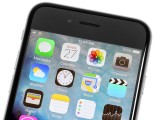
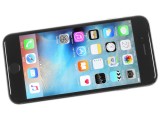
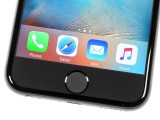 A peek above and below the display
A peek above and below the display
Below the display is the Home button, which also hosts the refined
Touch ID sensor. It's noticeably faster than before. About time too!
Although Apple brought the technology back from the dead, it's among the
last to improve the performance of the sensor. In an ideal world we
would have also got an always on mode so you don't have to press the
button and wake the phone, but even so the iPhone 6s still has one of
the better working solutions on the market.
The volume keys and the silencer are on the left, while the power/lock key and the nano-SIM tray are on the right as usual.
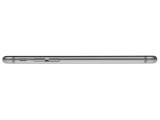
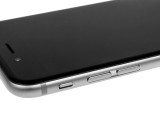
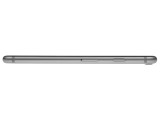
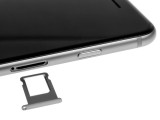 The left and right sides of the iPhone 6s
The left and right sides of the iPhone 6s
There is nothing on top of the iPhone 6s, while the bottom has the
audio jack, the primary mic, the Lightning port, and the loudspeaker
grille.
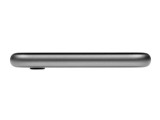
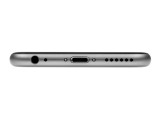
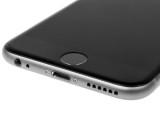 The top and bottom of the iPhone 6s
The top and bottom of the iPhone 6s
The iPhone 6s rear side is as familiar as it can get - the camera is
there, the second mic and the dual-LED dual-tone flash. The new 12MP
sensor allows for wider panorama photos and 4K video recording, while
the more powerful hardware enables 120fps capture at 1080p resolution.
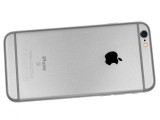
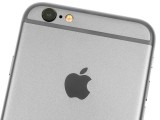
Display
While the display may hide an entirely new touch technology, it's
still the same display in terms of size and resolution: a 4.7" unit with
a resolution of 750 x 1334 pixels (that's 326ppi). It's a LED-backlit
IPS LCD screen with RGB matrix.
The Apple iPhone 6s display offers deeper blacks than the iPhone 6
but unfortunately, it's not as bright at its maximum setting.
Nevertheless, the new generation of iPhone managed to output an overall
better contrast ratio of 1481:1.
The color rendition of the screen is generally accurate with a pretty
low average deltaE of 3.6 (for the primary colors plus black and
white), and it's the white and reds that show a somewhat higher
deviation. The white is slightly on the cooler bluish side, but nothing
major and certainly not noticeable without a reference.
As usual, display colors are a matter of personal taste and
perception so if you don't need calibrated color output, you will
probably be quite happy with the Apple iPhone 6s screen as it is
out-of-the-box.
As far as sunlight legibility is concerned, the slightly lower
brightness of the iPhone 6s outs a whisker lesser score than its
predecessor, the 6, but it's still among the top 20 devices in our
all-time chart. This means the contrast in direct sunlight remains
excellent in all cases.

Battery life
The iPhone 6S is equipped with a non-removable Li-Po 1715 mAh
battery, which is about 5% smaller than the one of the iPhone 6. iOS 9
introduced a Low-Power mode, which you can enable manually and should
save your phone from dying faster once the charge drops below 20%.
We were eager to see how the new features will affect the battery
life, especially when the battery unit got even smaller. The iPhone 6s
posted very balanced score across all of our tests - it can do about 10
hours of 3G calls or video playback on a single charge, while you can
browse on Wi-Fi for half a day.
So, the total ratting of the iPhone 6s is 62 hours - an hour better
than the iPhone 6. This means 62 hours is how long a single battery
charge will last you if you use the iPhone 6s for an hour each of
telephony, web browsing, and video playback daily. Such usage pattern is
of course entirely artificial, but we've established it so our battery
results are comparable across devices.
Our proprietary score also includes a standby battery draw test,
which is not featured in our battery test scorecard but is calculated in
the total endurance rating. Our
battery testing procedure is described in detail in case you want to learn more about it.
Connectivity
The Apple iPhone 6S comes with a bunch of wireless connectivity
features. It supports faster LTE Cat. 6 (up to 3000Mpbs down, 50Mbps up)
and has even wider LTE coverage. Regular 2G and 3G connectivity is all
safely covered as well with a multitude of supported network bands.
The iPhone 6S also supports the latest Voice over LTE (VoLTE), HD
Voice and Wi-Fi calling protocols, but those are carrier dependent
features so not everyone will enjoy them.
Compared to the iPhone 6, the 6S now upgraded Wi-Fi functionality too
- it supports all the current Wi-Fi a/b/g/n/ac standards but doubles
the theoretical speeds thanks to the use of a 2x2 MIMO antenna. AirPlay
is the only way to wirelessly cast your screen's contents to an HDTV,
but you'd need to have an Apple TV for that.
Additional local connectivity includes Bluetooth 4.0 LE. There is
also support for NFC, but its functionality is only limited to Apple's
region-restricted Apple Pay.
The iPhone 6s uses a proprietary Lightning connector for wired data transfers and charging.
There is no support for USB On-the-go or USB host but you can pair a
Bluetooth keyboard to the phone should you need this sort of peripheral.
Apple iOS 9 - some new features, lots of potential
Sticking to its usual practices, Apple unveiled the new iOS 9 in
June, but at that point it didn't cause too much excitement. Looking
much like iOS 8 and bringing only a handful of new features, it didn't
stay in the spotlight for long.
Now, a few months later things are different - the iOS 9 biggest
update wasn't mentioned at the announcement for understandable reasons -
it's the support of the new 3D Touch display and the API that will be
available to game and app developers. Depending on how it goes with the
early adopters, this feature alone has the potential to alter the way we
interact with our phones the same way the first capacitive display and
the multi-touch gestures did.

The support for 3D Touch allows for another level of interaction,
press the screen for a bit longer (and harder). This gets you access to
extra actions and contextual options and we can't wait to see how say,
game developers put that to use in the months to come. We'll get back to
examining Touch ID and its impact on iOS 9 in a short while, but first
let's cover the basics of the new Apple platform.
iOS 9 brings a couple of new apps - News and Notes, while also
enhancing Maps with public transit support. Mail and Messages got
refreshed and there's a new system font. Meanwhile Siri got smarter,
while Spotlight Search expanded its reach.
Visually iOS 9 looks the same as its predecessor. All of your apps
are on the homescreen, you can group them in folders and there is the
familiar dock that can take up to four shortcuts. System icons, color
themes and transparency - everything is like we left it in iOS 8.
The lockscreen hasn't changed much either, but it now supports Live
Photo wallpapers - they are either short animations or you can use one
of thoseLive Photos that the iPhone 6s duo is capable of capturing. For
the animation to activate, you need to press firmly on the screen, which
is somewhat counterintuitive and we doubt it will be an oft used
feature as nobody would really want to hard press the screen for 3
seconds just to see their lockscreen wallpaper move a bit.

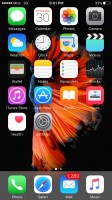
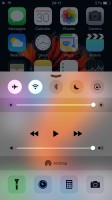

 The lockscreen • The homescreen • Control Center • Notification Center
The lockscreen • The homescreen • Control Center • Notification Center
The Control Center that's pulled up from the bottom of the screen
keeps the same layout of toggles, shortcuts and media controls. The
Notification Center drops from the top and features the same Today and
Notification tabs. There are no new widgets or notification options.
The task-switcher interface loses its webOS flat cards look and opts
for a cooler 3D carousel. Unfortunately, you are still able to only see
just three apps, and it takes even more scrolling so we're not quite
happy with this change.
 The new task manager
The new task manager
The iPhone 6s supports quick app switching between opened apps via a
Force Touch gestures. Just swipe from the far left side of the screen
with a firm touch and you'll get to the app switcher. Upon choosing the
app you want to go to, this gesture starts alternating your current app
and the one you've selected. Say you are browsing and Facebook chatting
simultaneously, you can switch between the two apps with just a firm
swipe from the left. It sounds a bit complicated but it's actually quite
intuitive once you try it.
The Spotlight search has been improved. You can invoke it by a
downwards swipe from anywhere on the homescreen, or go to the leftmost
pane. It has been updated and can now do simple calculations and
conversions. It also supports finding sport scores and weather forecast
information. And finally, you get shortcuts for making a call or sending
a message to any of the contact results in the Spotlight searches.
Siri got smarter, too. In addition to all the cool stuff the
intelligent assistant could do before, it can now search through your
photos and videos based on dates, locations and the album names. It
supports custom reminders from things you've been searching for in
Safari, Mail, Notes and Messages and it got support for public transit
navigation too.

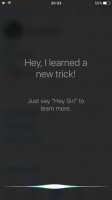 Siri can be summoned anytime by saying 'Hey, Siri'
Siri can be summoned anytime by saying 'Hey, Siri'
Next, there is the new pro-active assistance available system-wide,
which is more or less Apple's take on Google Now - it provides relevant
information to you in advance - before you start typing something or
before you leave for some place (work, home).
Finally, iOS 9 extends the overall language support for Siri,
Spotlight, the predictive input, dictation support, dictionaries and
spell check. Siri is now available in Austrian German, Belgian French
and Norwegian, while Mexico gets its proper Spotlight support.
Predictive input is now available in Belgian French, Austrian
German, Gujarati, Hindi, Hinglish, Punjabi, Mexican Spanish and Telugu.
Finland and Korea get spell check. Last, but not least, dictation is now
available for Belgium (Dutch and French), English for Ireland,
Philippines, and South Africa, Austria (German) and Spanish for Chile
and Colombia.
When it comes to predictive input, iOS 9 would gradually learn the
way you type and search and would eventually become a passive yet very
useful assistant. This will take off some pressure of Siri and yet make
your interactions with the iPhone much easier and pleasant.
3D Touch aims to be the next big thing
Currently 3D Touch gestures are available only on selected system
app. You can use it on the lockscreen, the homescreen and within apps.
We already talked about the lockscreen gimmick, let's see what it does
on the homescreen.

Force pressing on the Message icon pops up a balloon with a New
Message shortcut and a short list of your most recent messaging
contacts. Force clicking on the Phone app gives you a - Create New
Contact key and a short list of recently contacted people.

 Force Touch on Messages and Phone apps
Force Touch on Messages and Phone apps
Applying force on the Calendar pops up New Event option; on the Clock
- New Alarm/Start Timer/Stopwatch; on Maps - Directions to Home, Share
location, drop pin and search nearby; on the Stores - Redeem and Search;
on the Camera - Take Photo, Take Selfie, Record Video and Record
Slow-mo.


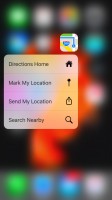
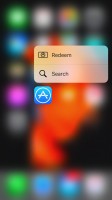
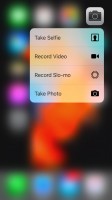 Force Touch on Calendar, Clock, Maps, App Store and Camera apps
Force Touch on Calendar, Clock, Maps, App Store and Camera apps
Continuing on Safari - you get Show Reading List, Bookmark list, New
Private tab and New tab; Mail offers shortcuts to Inbox, VIP, New
message and Search; Music has Play Beats; and Notes - New Note, New
Sketch and New Photo note.
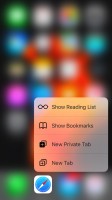
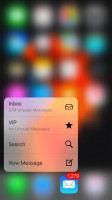 Force Touch on Safari and Mail
Force Touch on Safari and Mail
As you can see those force taps on the homescreen are indeed useful
sometimes, but are hardly something you can't live without. What really
matters is what you can do
within the apps with 3D Touch.
3D Touch is meant to allow you to get more content than you normally
get on a screen, so that you can give it a quick glance and let it go -
all of this with just one firm long press.
If you press hard on an email within the Mail app, first it will be
selected by blurring all the others. Applying slightly more force will
pop its contents into a balloon for you to see it. Here you can either
apply more force to open the whole email, or release your finger thus
you'll be back on the email list.

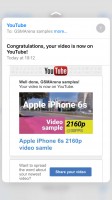
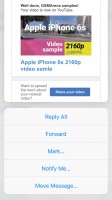 Force Touch within Mail app
Force Touch within Mail app
While you are holding the Mail balloon open, you can swipe it up and
you'll get advanced options such as Reply, Forward, Mark, Notify Me and
Move.
You can do the same on Messages - a firm press opens a preview of
your most recent messages with this contact and if you keep pressing
you'll eventually open the full thread.


 3D Touch within Messages app
3D Touch within Messages app
Tapping with force on a contact in the Phone app pops up Mail,
Message and Call shortcuts. Tapping on a day in the Calendar pops up a
preview of the day's events and will eventually open the full day view.
The Notes app has the same logic.



 3D Touch within Phone, Calendar and Notes
3D Touch within Phone, Calendar and Notes
Force touch on a photo in the gallery will pop up a photo preview. If
you move your finger towards the top you'll reveal a menu with copy,
share and delete settings. If you swipe down or just release, you'll put
this photo back on the pile.

 Force Touch within Photos
Force Touch within Photos
And if you opened the photo already, a strong Touch will invoke its Live Photo, if available.
Safari also takes advantage of Force Touch - hit a link firmly and
you get a pop up with the linked page and if you like what you see you
can press harder to open it, or just release it for discarding.
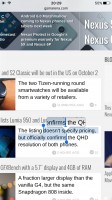
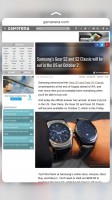
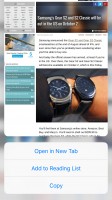 Selecting text with 3D Touch in Safari • Force Touch on links in Safari
Selecting text with 3D Touch in Safari • Force Touch on links in Safari
Finally, one of the most meaningful uses of the Force Touch is
selecting text. If you do a standard tap and hold on text you'll begin
scrolling through the words. And when you apply force to activate the
Force Touch, you begin text selection from this very moment. This eases
the entire text selection process tremendously - just scroll to your
desired place and force touch from there and continue scrolling until
you're done.
That's basically all of it at the moment - it's not much and certainly most of the functionality feels, if you pardon the pun,
forced
rather than intuitive and helpful. However, we get the feeling that
Apple is simply trying to give hints to developers with those. Those are
just ideas with the hope that developers will actually put the feature
to great use in their apps.
Given the chance, 3D Touch may turn to be a breakthrough that will
shape smartphone usage for years to come. Similar to what Apple did with
multi-touch or the fingerprint sensor.
What does add more fuel to the 3D Touch fire is that other
manufacturers began announcing phones with similar tech shortly before
Apple's event, so there will be more companies that want to see it
succeed and in turn more developers willing to give it a proper
consideration














































 The support for 3D Touch allows for another level of interaction,
press the screen for a bit longer (and harder). This gets you access to
extra actions and contextual options and we can't wait to see how say,
game developers put that to use in the months to come. We'll get back to
examining Touch ID and its impact on iOS 9 in a short while, but first
let's cover the basics of the new Apple platform.
The support for 3D Touch allows for another level of interaction,
press the screen for a bit longer (and harder). This gets you access to
extra actions and contextual options and we can't wait to see how say,
game developers put that to use in the months to come. We'll get back to
examining Touch ID and its impact on iOS 9 in a short while, but first
let's cover the basics of the new Apple platform.












 Force pressing on the Message icon pops up a balloon with a New
Message shortcut and a short list of your most recent messaging
contacts. Force clicking on the Phone app gives you a - Create New
Contact key and a short list of recently contacted people.
Force pressing on the Message icon pops up a balloon with a New
Message shortcut and a short list of your most recent messaging
contacts. Force clicking on the Phone app gives you a - Create New
Contact key and a short list of recently contacted people.



























Follow Us
Were this world an endless plain, and by sailing eastward we could for ever reach new distances